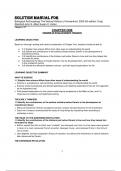Solution Manual For
Biological Anthropology The Natural History of Humankind, 2025 5th edition Craig
Stanford John S. Allen Susan C. Anton
Chapter 1-17
CHAPTER ONE
ORIGINS OF EVOLUTIONARY THOUGHT
LEARNING OBJECTIVES
Based on thorough reading and careful consideration of Chapter One, students should be able to:
● 1.1: Explain how science differs from other ways of understanding the world.
● 1.2: Identify the contributions of the earliest scholars before Darwin to the development of
evolutionary theory.
● 1.3: Identify the contributions of the thinkers just before Darwin’s time and how they helped him
formulate his ideas.
● 1.4: Describe the ideas of Charles Darwin, how he developed them, and how they were received
in the nineteenth century
● 1.5: Identify the difference between science- and faith-based explanations for life.
LEARNING OBJECTIVE SUMMARY
WHAT IS SCIENCE
1.1 Explain how science differs from other ways of understanding the world.
Science is a progressive, self-correcting, evidence-based way of understanding the world.
Science works by proposing and testing hypotheses and rejecting explanations that are not supported
by the hypothesis test.
Faith-based explanations for the natural world require acceptance of the Bible as fact, and it is
impervious to evidence and hypothesis testing.
THE EARLY THINKERS
1.2 Identify the contributions of the earliest scholars before Darwin to the development of
evolutionary theory.
Many pre-Darwinian thinkers accepted evolution and put forward theories for the mechanism.
Carol von Linnaeus revolutionized the study of living things by classifying them according to
similarities in form.
THE ROAD TO THE DARWINIAN REVOLUTION
1.3 Identify the contributions of the thinkers just before Darwin’s time and how they helped him
formulate his ideas
Buffon argued that life on Earth was ―mutable‖ and changed over time, but his views were ignored
in favor of a more renowned French scientist, Georges Cuvier, who believed firmly in the fixity of
life on Earth.
Jean-Baptiste Lamarck proposed a theory of evolution, but without the mechanism of natural selection
later discovered by Darwin.
THE DARWINIAN REVOLUTION
5
,1.4 Describe the ideas of Charles Darwin, how he developed them, and how they were received in
the nineteenth century.
Charles Darwin spent his life thinking and writing about evolutionary change; he developed the theory
of evolution by natural selection to account for it.
Darwin’s observations in the Galapagos and for many years after led him to develop his ideas about
natural selection.
Alfred Russel Wallace was a contemporary of Darwin and codiscoverer of the theory of evolution by
natural selection.
Evolution was accepted long before Darwin; he provided the mechanism for how it works: natural
selection.
Darwin drew on evidence from biogeography, embryology, the fossil record, and animal domestication
to support his theory of natural selection.
Darwin was deeply conflicted about the challenge his ideas brought to Christianity and potential
embarrassment to his family.
The Origin of Species was published in the fall of 1859 and quickly sold out of London bookstores.
Darwin’s rivals were slow to accept natural selection, whereas some scientists quickly embraced it.
SCIENCE AND CREATIONISM
1.5 Identify the difference between science- and faith-based explanations for life.
Science can be falsified; faith-based explanations cannot.
Science is progressive; new technologies improve our scientific understanding.
Science does not claim to prove; instead, it upholds or refutes hypotheses.
Intelligent design creationism is a recent attempt to repackage old creationist ideas in a way that
argues for a divine force without calling it God.
LECTURE OUTLINE
I. Introduction
A. Battles between teaching evolution and creationism
1. The Dover Case and the Scopes Trial
B. Life on Earth as unchanging
1. The scale of evolution
2. Uses of the term theory
II. What Is Science?
A. The scientific method
1. Developing a hypothesis: a preliminary explanation of a phenomenon
2. Moving from observation to data to experiment
3. Experiments: the testing of a hypothesis, before the researcher can truly stake their claim
B. Science is an empirical process
1. Theories are self-correcting.
a. Contradicting claims can be examined and resolved by examining data.
2. Theories are falsifiable
a. Science uses paradigms, conceptual frameworks for understanding a body of evidence
b. Changing paradigms may involve conflicting evidence and debate
III. The Early Thinkers
A. Aristotle and the fixity of species
1. The concept of immutability or fixity of species
a. For centuries, life was thought of as an orderly, hierarchical ladder, with humans at the
very top
B. The Roots of Modern Science
1. The Middle Ages
6
, a. Fixity of species was the spiritual, legal, and political norm.
b. Adoption of Aristotle’s Great Chain of Being
2. The Renaissance and challenge to church doctrine
a. da Vinci’s and Vesalius’s anatomical drawings changed scholars’ perception of the
human body
b. The first circumnavigation of the globe and European exploration of the Americas
i. revealed the diversity of life in the Americas
ii. polygenism: idea that life derived from multiple creations
iii. monogenism: the ancient belief that all people are derived from a single creation
c. Samuel Stanhope Smith’s and Johann Friedrich Blumenbach’s strong support of
monogenism
d. James Ussher’s biblical calculations of the age of the Earth
e. Galileo’s house arrest for his publication describing a helio-centric universe
C. Linnaeus and the Natural Scheme of Life
1. John Ray first to use the terms genus and species.
2. Carolus Linnaeus built on Ray’s writings to create comprehensive classification of plant and
animal life.
a. Taxonomy
i. sorting organisms into categories helped to establish their relationships
ii. Linnaean system of taxonomy uses binomial nomenclature, or a two-level genus-
species label.
iii. ―taxon‖ is any unit of Linnaean hierarchy
IV. The Road to the Darwinian Revolution
A. In the eighteenth and early nineteenth centuries, European natural historians focused on
explaining the diversity of life.
B. Three prominent French philosophers
1. Comte de Buffon
a. Accepted general notion of biological change
b. Observed that animals in new climates often change in response to environments
c. Claimed that animals in the Americas were weaker and smaller than their counterparts
in the rest of the world
2. Georges Cuvier
a. Steadfast opponent of modern concept of evolutionary change
b. Advocated catastrophism to explain presence of dinosaur bones and changing
organisms
c. Catastrophism: the theory that cataclysmic events wiped out earlier forms of life on
Earth
i. Noah’s flood
ii. replacement populations more advanced than original forms
3. Geoffroy Saint-Hilaire
a. An anatomist and a strong advocate of evolutionary change
b. Publically debated Cuvier
c. Supported Lamarck’s explanation for the mechanism of evolution
C. Jean-Baptiste Lamarck
1. Theory of Inheritance of Acquired Characteristics (Lamarckianism)
a. Organisms adjust to their environment during their lifetime
b. Relies on the concept of need and use
i. animals that swim frequently would theoretically have offspring who could swim
well
c. Under Lamarckianism, adjusted traits would be passed down to offspring
2. His major breakthrough was the relationship between organism and environment
3. Theory’s central error is that evolution would take during the lifetime of individual organism
4. a. Mode of inheritance (e.g., genes) unknown at time
b. Natural antecedent to Darwin’s theory
5. Lysenkoism and its failure
7
, a. Untrained Soviet biologist Trofim Lysenko argued Darwinian evolution was inherently
capitalist
i. rejected capitalist focus on individual success
ii. rejected exponential population growth and competition for resources outlined by
Thomas Malthus
b. Argued Lamarchianism was a Stalinist-Marxist model
i. stored wheat grains at low temperatures so they could ―adjust‖ to colder weather
conditions
c. Tragic and embarrassing failure
D. The Uniformitarians: Hutton and Lyell
1. James Hutton
a. Father of modern geology
b. Saw clear evidence of past worlds in rock formations
2. Uniformitarianism
a. Same geological processes observed today were the same as those operating in the
past
3. Charles Lyell
a. Proponent of uniformitarianism
b. Friendship with Darwin helped influenced evolutionary ideas
c. Earth’s history understood in context of deep, ancient changes in geology
V. The Darwinian Revolution
A. Darwin’s early years
1. Born into life of affluence
2. Left medical studies at University of Edinburgh
3. Studied for the ministry at Cambridge University
a. Deeply influenced by his professor, botanist John Henslow
b. Inspired by travel and natural history accounts of Baron Friedrich Heinrich Alexander
von Humboldt
c. Received divinity degree in 1831
4. HMS Beagle
a. Henslow recommended Darwin as the ―gentleman‖ amateur naturalist
B. The Galapagos
1. Five-year voyage as naturalist aboard the HMS Beagle (1831–1836)
2. Explored South America, Australia, and Africa
3. Significant collections in the Galapagos Islands
a. Each island had its own species of finch with different physical traits
b. Darwin did not immediately formulate the theory of natural selection
c. Collected 13 species of finch for the British Museum
d. Gould’s discovery of beak differences among finches
4. Importance of the finches
a. Biogeography: the distribution of animals and plants on Earth
b. Adaptive radiation: biological process of many species emerging from a few ancient
ones
c. Darwin referred to the process of biological change in a species as natural selection
5. Galapagos observations
a. Galapagos Islands perfect setting for Darwin’s theory
b. Isolated islands, geologically young, biologically simple
c. Species on islands found nowhere else, but many closely related
d. Islands lack many animal groups found on the mainland
e. Distinctive species tend to resemble close relatives on the mainland, even in different
environments
i. incorporated evidence from embryology
ii. many organisms bear vestigial organs: body parts that seem to serve no modern
purpose
C. Refining the Theory of Evolution by Natural Selection
1. Spent years developing theory of natural selection
8






